Topic 04 非遗传承二轮专题学案(含答案解析)-2025年初中英语中考传统文化阅读与写作专练(第二期)
文档属性
| 名称 | Topic 04 非遗传承二轮专题学案(含答案解析)-2025年初中英语中考传统文化阅读与写作专练(第二期) |
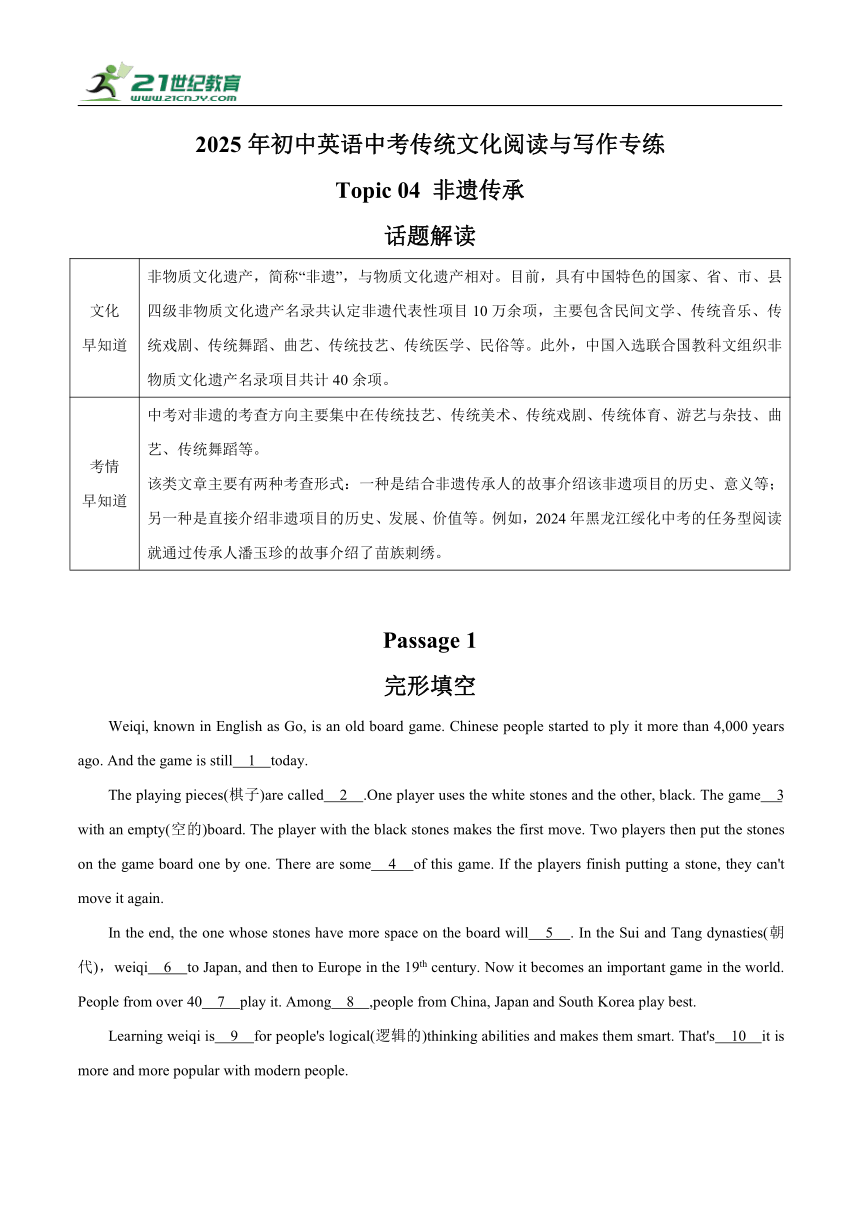
|
|
| 格式 | docx | ||
| 文件大小 | 76.2KB | ||
| 资源类型 | 试卷 | ||
| 版本资源 | 人教新目标(Go for it)版 | ||
| 科目 | 英语 | ||
| 更新时间 | 2025-04-13 20:48:54 | ||
图片预览

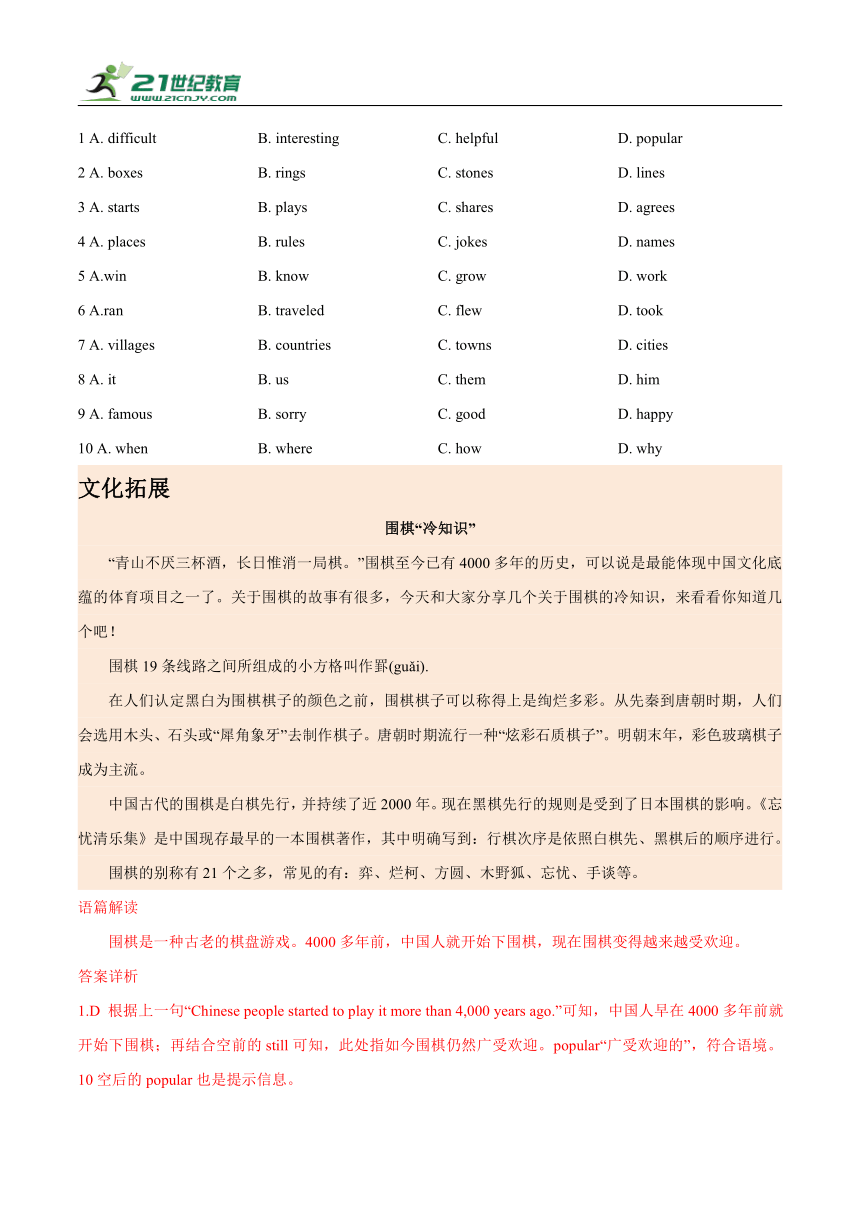
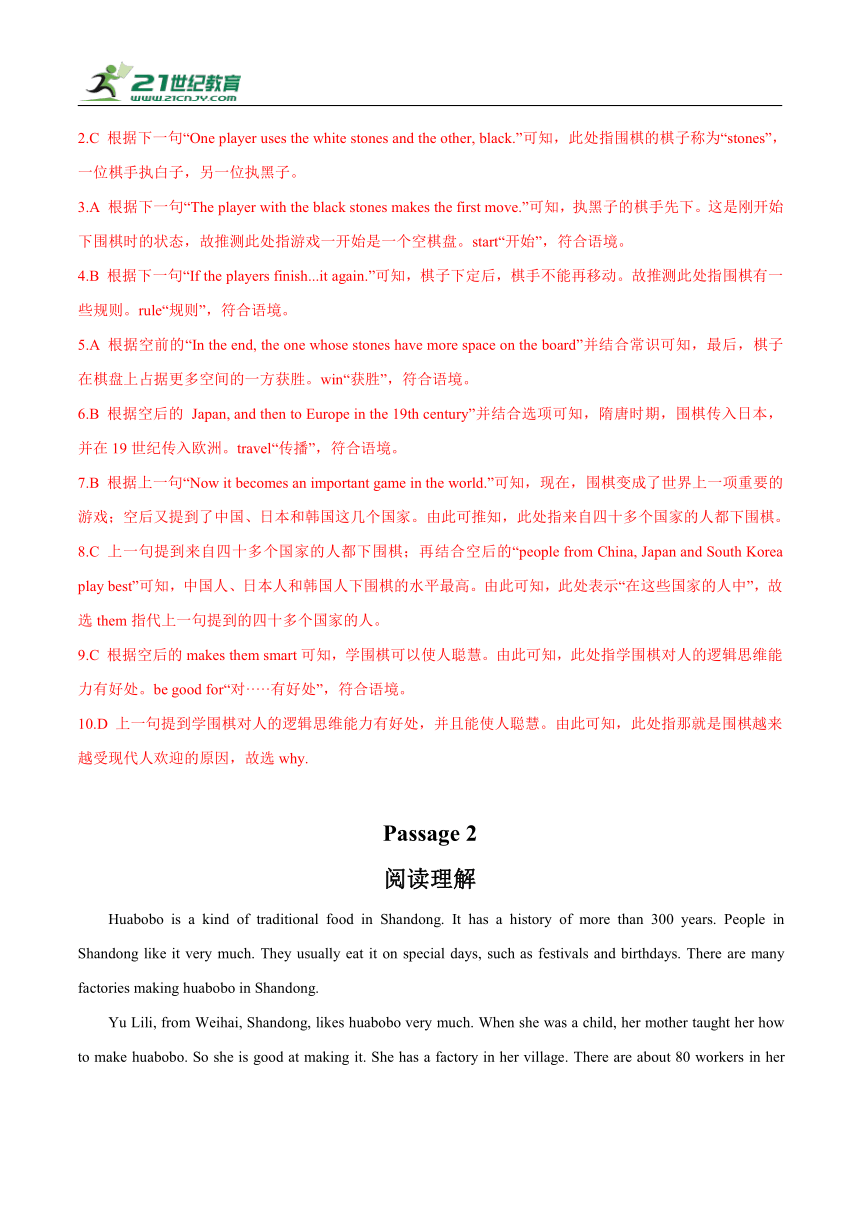
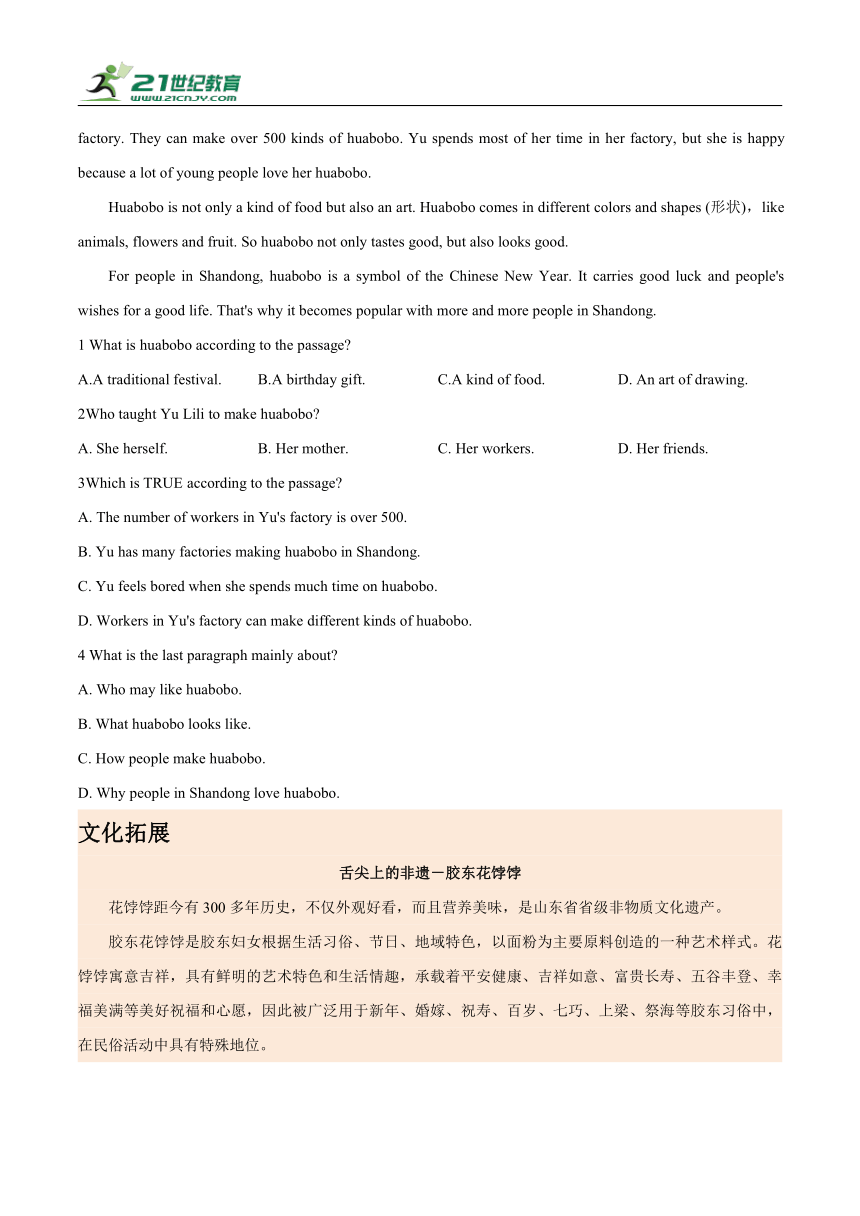
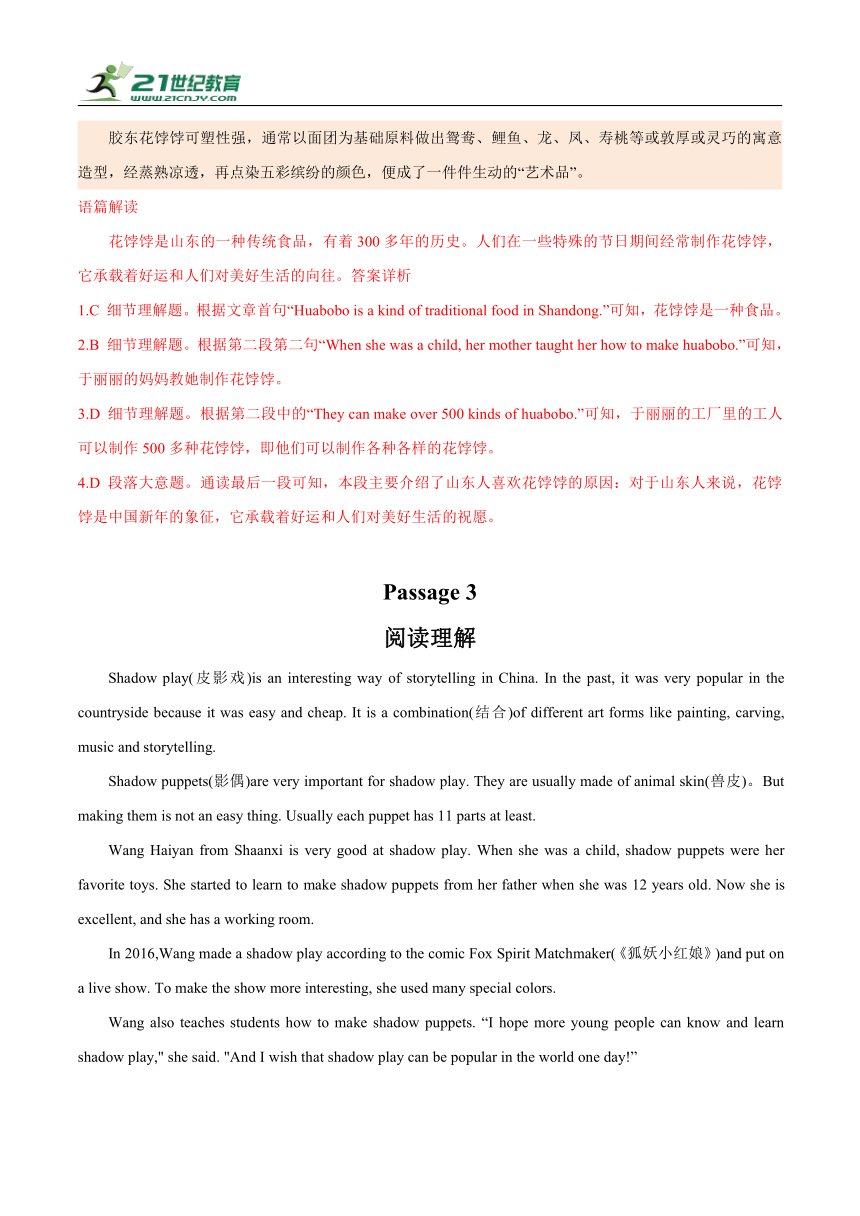
文档简介
2025年初中英语中考传统文化阅读与写作专练
Topic 04 非遗传承
话题解读
文化 早知道 非物质文化遗产,简称“非遗”,与物质文化遗产相对。目前,具有中国特色的国家、省、市、县四级非物质文化遗产名录共认定非遗代表性项目10万余项,主要包含民间文学、传统音乐、传统戏剧、传统舞蹈、曲艺、传统技艺、传统医学、民俗等。此外,中国入选联合国教科文组织非物质文化遗产名录项目共计40余项。
考情 早知道 中考对非遗的考查方向主要集中在传统技艺、传统美术、传统戏剧、传统体育、游艺与杂技、曲艺、传统舞蹈等。 该类文章主要有两种考查形式:一种是结合非遗传承人的故事介绍该非遗项目的历史、意义等;另一种是直接介绍非遗项目的历史、发展、价值等。例如,2024年黑龙江绥化中考的任务型阅读就通过传承人潘玉珍的故事介绍了苗族刺绣。
Passage 1
完形填空
Weiqi, known in English as Go, is an old board game. Chinese people started to ply it more than 4,000 years ago. And the game is still 1 today.
The playing pieces(棋子)are called 2 .One player uses the white stones and the other, black. The game 3 with an empty(空的)board. The player with the black stones makes the first move. Two players then put the stones on the game board one by one. There are some 4 of this game. If the players finish putting a stone, they can't move it again.
In the end, the one whose stones have more space on the board will 5 . In the Sui and Tang dynasties(朝代),weiqi 6 to Japan, and then to Europe in the 19th century. Now it becomes an important game in the world. People from over 40 7 play it. Among 8 ,people from China, Japan and South Korea play best.
Learning weiqi is 9 for people's logical(逻辑的)thinking abilities and makes them smart. That's 10 it is more and more popular with modern people.
1 A. difficult B. interesting C. helpful D. popular
2 A. boxes B. rings C. stones D. lines
3 A. starts B. plays C. shares D. agrees
4 A. places B. rules C. jokes D. names
5 A.win B. know C. grow D. work
6 A.ran B. traveled C. flew D. took
7 A. villages B. countries C. towns D. cities
8 A. it B. us C. them D. him
9 A. famous B. sorry C. good D. happy
10 A. when B. where C. how D. why
文化拓展
围棋“冷知识”
“青山不厌三杯酒,长日惟消一局棋。”围棋至今已有4000多年的历史,可以说是最能体现中国文化底蕴的体育项目之一了。关于围棋的故事有很多,今天和大家分享几个关于围棋的冷知识,来看看你知道几个吧!
围棋19条线路之间所组成的小方格叫作罫(guǎi).
在人们认定黑白为围棋棋子的颜色之前,围棋棋子可以称得上是绚烂多彩。从先秦到唐朝时期,人们会选用木头、石头或“犀角象牙”去制作棋子。唐朝时期流行一种“炫彩石质棋子”。明朝末年,彩色玻璃棋子成为主流。
中国古代的围棋是白棋先行,并持续了近2000年。现在黑棋先行的规则是受到了日本围棋的影响。《忘忧清乐集》是中国现存最早的一本围棋著作,其中明确写到:行棋次序是依照白棋先、黑棋后的顺序进行。
围棋的别称有21个之多,常见的有:弈、烂柯、方圆、木野狐、忘忧、手谈等。
语篇解读
围棋是一种古老的棋盘游戏。4000多年前,中国人就开始下围棋,现在围棋变得越来越受欢迎。
答案详析
1.D 根据上一句“Chinese people started to play it more than 4,000 years ago.”可知,中国人早在4000多年前就开始下围棋;再结合空前的still可知,此处指如今围棋仍然广受欢迎。popular“广受欢迎的”,符合语境。10空后的popular也是提示信息。
2.C 根据下一句“One player uses the white stones and the other, black.”可知,此处指围棋的棋子称为“stones”,一位棋手执白子,另一位执黑子。
3.A 根据下一句“The player with the black stones makes the first move.”可知,执黑子的棋手先下。这是刚开始下围棋时的状态,故推测此处指游戏一开始是一个空棋盘。start“开始”,符合语境。
4.B 根据下一句“If the players finish...it again.”可知,棋子下定后,棋手不能再移动。故推测此处指围棋有一些规则。rule“规则”,符合语境。
5.A 根据空前的“In the end, the one whose stones have more space on the board”并结合常识可知,最后,棋子在棋盘上占据更多空间的一方获胜。win“获胜”,符合语境。
6.B 根据空后的 Japan, and then to Europe in the 19th century”并结合选项可知,隋唐时期,围棋传入日本,并在19世纪传入欧洲。travel“传播”,符合语境。
7.B 根据上一句“Now it becomes an important game in the world.”可知,现在,围棋变成了世界上一项重要的游戏;空后又提到了中国、日本和韩国这几个国家。由此可推知,此处指来自四十多个国家的人都下围棋。
8.C 上一句提到来自四十多个国家的人都下围棋;再结合空后的“people from China, Japan and South Korea play best”可知,中国人、日本人和韩国人下围棋的水平最高。由此可知,此处表示“在这些国家的人中”,故选them指代上一句提到的四十多个国家的人。
9.C 根据空后的makes them smart可知,学围棋可以使人聪慧。由此可知,此处指学围棋对人的逻辑思维能力有好处。be good for“对·····有好处”,符合语境。
10.D 上一句提到学围棋对人的逻辑思维能力有好处,并且能使人聪慧。由此可知,此处指那就是围棋越来越受现代人欢迎的原因,故选why.
Passage 2
阅读理解
Huabobo is a kind of traditional food in Shandong. It has a history of more than 300 years. People in Shandong like it very much. They usually eat it on special days, such as festivals and birthdays. There are many factories making huabobo in Shandong.
Yu Lili, from Weihai, Shandong, likes huabobo very much. When she was a child, her mother taught her how to make huabobo. So she is good at making it. She has a factory in her village. There are about 80 workers in her factory. They can make over 500 kinds of huabobo. Yu spends most of her time in her factory, but she is happy because a lot of young people love her huabobo.
Huabobo is not only a kind of food but also an art. Huabobo comes in different colors and shapes (形状),like animals, flowers and fruit. So huabobo not only tastes good, but also looks good.
For people in Shandong, huabobo is a symbol of the Chinese New Year. It carries good luck and people's wishes for a good life. That's why it becomes popular with more and more people in Shandong.
1 What is huabobo according to the passage
A.A traditional festival. B.A birthday gift. C.A kind of food. D. An art of drawing.
2Who taught Yu Lili to make huabobo
A. She herself. B. Her mother. C. Her workers. D. Her friends.
3Which is TRUE according to the passage
A. The number of workers in Yu's factory is over 500.
B. Yu has many factories making huabobo in Shandong.
C. Yu feels bored when she spends much time on huabobo.
D. Workers in Yu's factory can make different kinds of huabobo.
4 What is the last paragraph mainly about
A. Who may like huabobo.
B. What huabobo looks like.
C. How people make huabobo.
D. Why people in Shandong love huabobo.
文化拓展
舌尖上的非遗-胶东花饽饽
花饽饽距今有300多年历史,不仅外观好看,而且营养美味,是山东省省级非物质文化遗产。
胶东花饽饽是胶东妇女根据生活习俗、节日、地域特色,以面粉为主要原料创造的一种艺术样式。花饽饽寓意吉祥,具有鲜明的艺术特色和生活情趣,承载着平安健康、吉祥如意、富贵长寿、五谷丰登、幸福美满等美好祝福和心愿,因此被广泛用于新年、婚嫁、祝寿、百岁、七巧、上梁、祭海等胶东习俗中,在民俗活动中具有特殊地位。
胶东花饽饽可塑性强,通常以面团为基础原料做出鸳鸯、鲤鱼、龙、凤、寿桃等或敦厚或灵巧的寓意造型,经蒸熟凉透,再点染五彩缤纷的颜色,便成了一件件生动的“艺术品”。
语篇解读
花饽饽是山东的一种传统食品,有着300多年的历史。人们在一些特殊的节日期间经常制作花饽饽,它承载着好运和人们对美好生活的向往。答案详析
1.C 细节理解题。根据文章首句“Huabobo is a kind of traditional food in Shandong.”可知,花饽饽是一种食品。
2.B 细节理解题。根据第二段第二句“When she was a child, her mother taught her how to make huabobo.”可知,于丽丽的妈妈教她制作花饽饽。
3.D 细节理解题。根据第二段中的“They can make over 500 kinds of huabobo.”可知,于丽丽的工厂里的工人可以制作500多种花饽饽,即他们可以制作各种各样的花饽饽。
4.D 段落大意题。通读最后一段可知,本段主要介绍了山东人喜欢花饽饽的原因:对于山东人来说,花饽饽是中国新年的象征,它承载着好运和人们对美好生活的祝愿。
Passage 3
阅读理解
Shadow play(皮影戏)is an interesting way of storytelling in China. In the past, it was very popular in the countryside because it was easy and cheap. It is a combination(结合)of different art forms like painting, carving, music and storytelling.
Shadow puppets(影偶)are very important for shadow play. They are usually made of animal skin(兽皮)。But making them is not an easy thing. Usually each puppet has 11 parts at least.
Wang Haiyan from Shaanxi is very good at shadow play. When she was a child, shadow puppets were her favorite toys. She started to learn to make shadow puppets from her father when she was 12 years old. Now she is excellent, and she has a working room.
In 2016,Wang made a shadow play according to the comic Fox Spirit Matchmaker(《狐妖小红娘》)and put on a live show. To make the show more interesting, she used many special colors.
Wang also teaches students how to make shadow puppets. “I hope more young people can know and learn shadow play," she said. "And I wish that shadow play can be popular in the world one day!”
1 How many art forms in shadow play are mentioned(提到)?
A. Two. B. Three. C. Four. D. Five.
2 What does the writer think of making shadow puppets
A. Difficult. B. Easy. C. Boring. D. Interesting.
3 What can we know about Wang Haiyan
A. She was born into a farmer's family.
B. She uses special colors in all of her shadow puppets.
C. She got interested in shadow play because of her father.
D. She tries to make shadow play popular with young people.
4 What does the passage mainly talk about
A. Wang Haiyan and her father.
B. Shadow play and Wang Haiyan.
C. How to make shadow puppets for shadow play.
D. Why shadow play was popular in the countryside.
文化拓展
“光与影的艺术”-皮影戏
皮影戏,又称灯影戏、纸影戏、驴皮影等,是一种集表演、歌唱、绘画、雕刻、音乐等多种艺术手段为一体的古老的综合性艺术,被称为中国民间艺术的“活化石”。表演时,艺人在幕后用木杆操控用兽皮或纸板做成的影偶,借灯光投射在半透明幕布上,并伴随着音乐和唱腔进行表演。
据传皮影戏最早诞生于2000多年前的西汉。据《汉书》记载,汉武帝爱妃李夫人染疾故去,汉武帝伤心难过,茶饭不思。某日大臣李少翁遇到孩童手拿布娃娃玩耍,阳光下布娃娃的影子倒映在地上,栩栩如生。李少翁受到启发,他以棉帛为材料制作了李夫人的影像,涂上色彩并在手脚处装上木杆,晚上围上方帷,恭请汉武帝端坐帐中观看。那影子就像真人一样栩栩如生,汉武帝看罢龙颜大悦,从此皮影戏渐渐流传下来。
语篇解读
皮影戏是中国的一种有趣的叙事方式。来自陕西的汪海燕正用自己的方式让更多年轻人了解皮影戏,并希望有朝一日皮影戏可以走向世界。
答案详析
1.C 细节理解题。根据第一段最后一句 is a combination...like painting, carving, music and story- telling.”可知,文中提到了绘画、雕刻、音乐和说书这四种融合在皮影戏中的艺术形式。
2.A 细节理解题。根据第二段第三句“But making them is not an easy thing.”可知,制作皮影戏的影偶不是一件容易的事情。
3.D 细节理解题。根据最后一段的内容可知,汪海燕教学生们制作影偶,并且她希望有更多年轻人能够了解并学习皮影戏。由此可知,汪海燕努力让皮影戏受到年轻人的欢迎。
4.B 主旨大意题。通读全文可知,本文主要介绍了皮影戏的历史、影偶的制作以及传承人汪海燕的故事。由此可知,本文主要谈论了皮影戏和汪海燕。
Passage 4
阅读理解
Bamboo weaving(竹编)has a long history in China and was listed as a national intangible cultural heritage(非物质文化遗产)in 2008.Most people may know bamboo baskets or bamboo chairs. However, we can also turn bamboo into beautiful and creative things.
In Golden Apple Jincheng No.1 Secondary School, there is a bamboo weaving club. Students can learn from local craftsmen(手艺人)about this traditional Chinese art. They make bamboo paintings, rings and other things.
"I'm interested in bamboo weaving," said 14-year-old Cheng Yangyi.“My first work is a bamboo fan. The job needs a lot of patience."When he first tried it, he often made mistakes. The thin strips(竹条)were either too close or too far from each other. Then he needed to start all over again. “I sometimes got angry. But when I finally finished the fan, all the restlessness just went away and I felt very proud,” Cheng said.
During the club activities, there are smooth(光滑的)bamboo strips for students to use. But it takes a lot of work to turn bamboo into strips, including cutting off its green skin(外皮),cutting it into thin pieces, and making sure the strips are as wide as each other. “It's amazing to know how the plants are, step by step, turned into fine artworks," said student Du Yihang.
1 In the bamboo weaving club, students
A. can buy the works of local craftsmen
B. can learn to make different kinds of things
C. can get more knowledge of planting bamboo
D. can make bamboo desks and chairs for their school
2 What is Cheng Yangyi's first work made of bamboo
A.A basket. B.A painting. C.A fan. D.A ring.
3 The underlined word “restlessness” means“”in Chinese.
A.恐惧 B.兴奋 C.快乐 D.烦躁
4 What are the steps of making bamboo artworks
a. Cut off the green skin of bamboo.
b. Make strips with the same width.
c. Cut bamboo into thin pieces.
d. Use strips to do bamboo weaving.
A. a-c-b-d B. a-b-c-d C. a-d-c-b D. b-d-c-a
5 How might Du Yihang feel when he finishes a bamboo work
A. Tired. B. Happy. C. Angry. D. Relaxed,
文化拓展
竹编艺术:中国传统手工艺的瑰宝
竹编艺术的历史源远流长。早在新石器时代,人们便开始利用竹子制作各种器具。随着时间的推移,竹编技艺逐渐成熟,成为人们生活中不可或缺的一部分。从实用的篮子、筐子到精美的屏风、坐垫,竹编艺人将竹子编织成各种富有创意和实用性的艺术品。
竹编艺术的价值不仅在于其实用性,更在于其独特的艺术魅力。竹编艺人凭借着精湛的技艺和独特的审美,将原本平淡无奇的竹子编织成一幅幅精美的画卷。他们将竹子劈成薄片,编织出各种纹理和图案,展现出令人惊叹的技艺和创造力。竹编艺术品不仅具有独特的美感,还蕴含着丰富的文化内涵。它们或寓意着吉祥如意,或代表着丰收与富饶,成为传统文化的载体。竹编艺术还被应用于建筑、室内设计等领域,为现代空间增添了一份古朴与典雅的气息。
语篇解读
竹编在我国有着悠久的历史,并于2008年被列为国家级非物质文化遗产。大多数人可能比较熟悉竹篮或竹椅,但在一所中学开设的竹编社团里,学生们正尝试编出新意。
答案详析
1.B 细节理解题。根据第二段中的“Students can learn from...make bamboo paintings, rings and other things.”可知,在竹编社团里,学生们可以向当地手艺人学习,制作竹画、竹戒指等物品。由此可知,他们可以在这里学习制作各种东西。
2.C 细节理解题。根据第三段第二句“My first work is a bamboo fan.”可知,他的第一个作品是一个竹扇。
3.D 词义猜测题。根据画线词所在句的上一句“I sometimes got angry.”可知,他有时候会生气,故推测画线词应该是因为生气而引发的情绪。此处指当他做完那个竹扇时,所有的烦躁都消失了,他感到非常自豪。restlessness意为“烦躁”。
4.A 细节理解题。根据最后一段的内容可知,在社团活动中,有光滑的竹条供学生们使用。但将竹子制成竹条需要很多工作,包括去掉竹子的青皮,将竹子劈成细条,并确保竹条的宽度相同。由此可知,A项为制作竹编艺术品的正确步骤。
5.B 推理判断题。根据文章最后一句中杜一航说的话“It's amazing to know how the plants are, step by step, turned into fine artworks”可知,他认为了解竹子这种植物是如何一步步变成艺术品的是令人惊叹的。由此可推知,当他完成一件竹制品时,他应该会非常高兴。
Passage 5
任务型阅读
Hou Yan, 50, is the president of the Ningxia Performing Arts Group Qinqiang Theater. She started learning Qinqiang Opera from her mother when she was 4 years old.
Learning Qinqiang Opera was very hard. In 1985, Hou studied at an art school in Ningxia. During the training, she had to hold each move for half an hour. A small mistake could mean she had to start all over again.
Her hard work paid off. Hou started to work in a troupe(剧团)in Yinchuan at the age of 16. But in 1993, pop and western music hit Qinqiang Opera hard. The troupe had to close and Hou left the opera stage. Luckily, China then worked hard to promote(弘扬) its traditional culture. Hou went back to the stage in 2000 and made a big success by performing Palm Civet for Prince(《狸猫换太子》).
Now, Hou's team gives hundreds of Qinqiang Opera performances every year in Ningxia. There are many young people in the team.“As we become more confident(自信的)about our culture, more young people become its promoters," Hou said.
根据短文内容,回答下列问题。
1 Who is Hou Yan's first Qinqiang Opera teacher
____________________________________________________________________________________________
2 What was learning Qinqiang Opera like for Hou
____________________________________________________________________________________________
3 Why did Hou's troupe close in 1993
____________________________________________________________________________________________
4 What does Hou's team do every year in Ningxia now
____________________________________________________________________________________________
5 As a student, what can you do to promote our culture
____________________________________________________________________________________________
文化拓展
别开生面的新版《狸猫换太子》
传统戏剧《狸猫换太子》根据民间传说改编而来。传说宋真宗时,刘妃与内监郭槐合谋,以剥皮狸猫调换李妃所生婴儿,导致李妃被打入冷宫。宋真宗死后,宋仁宗赵祯即位,包拯奉旨赴陈州查处国舅庞昱放赈舞弊案,途中受理李妃冤案并为其平冤,迎李妃还朝。
《狸猫换太子》对宁夏演艺集团秦腔剧院院长侯艳有着特殊的意义。2000年,侯艳表演的秦腔《狸猫换太子》成为首届中国秦腔艺术节中的一匹黑马。戏曲艺术如何守正创新,是每个戏曲表演艺术家都绕不开的话题。对于新版《狸猫换太子》,侯艳的“答卷”是剧本、音乐保留经典不变,但导演风格更加写意、细腻,舞台效果整体大气,服装多是渐变色,更时尚,大胆起用年轻演员担纲主角等,这份“答卷”博得了满堂喝彩。新版以大写意的手法表现不同场景,布景和灯光也都有大幅度提升,整体简约大气。很多演员的服装也有变化,不仅体现身份地位,视觉上也更端庄雅致,符合当下人们的审美。
语篇解读
本文主要介绍了国家级非物质文化遗产-秦腔,以及宁夏演艺集团秦腔剧院院长侯艳学习并传播秦腔的故事。
答案详析
1.Her mother.根据第一段中的“She started learning Qinqiang Opera from her mother when she was 4 years old.”可知,侯艳四岁时开始跟她的妈妈学习秦腔。由此可知,侯艳的妈妈是她的第一位秦腔老师。
2.It was very hard.根据第二段的内容尤其是第一句“Learning Qinqiang Opera was very hard.”可知,对侯艳来说,学习秦腔非常艰辛。
3.Because pop and western music hit Qinqiang Opera hard.根据第三段第三句“But in 1993, pop and western music hit Qinqiang Opera hard.”可知,1993年,由于流行乐和西方音乐沉重打击了秦腔,这个剧团不得不关闭。
4.It gives hundreds of Qinqiang Opera performances.根据最后一段第一句“Now, Hou's team gives hundreds of Qinqiang Opera performances every year in Ningxia.”可知,如今侯艳的团队每年在宁夏进行数百场秦腔表演。
5.I can play the guzheng at our school concert and make more students interested in it.(开放性题目,答案合理即可)
Passage 6
短文填空
根据短文内容,从方框中选出正确的单词并用其适当形式填空。
join important luck over symbol practice he like real because
Chinese people all know lion dance. We think it is one of China's 1 .People play it during festivals because they believe it will bring good 2 .It isn't something new. But during the Spring Festival this year, a video caught people's eyes. 3 10,000 people gave a“ like” to it.
In the video, a lovely girl is 4 lion dance in front of her dad's store. And some lion dancers are playing the drums for her. In fact, they just passed by(经过) and didn't know the girl. “She is so great and we can see that she 5 loves lion dance," one dancer said.
The girl is Lin Xiyue from Guangdong. Her father 6 kung fu and lion dance very much. She learns a lot from 7 .And she keeps playing lion dance every day. Lin wants 8 other dancers for a big show in front of more people.
People enjoyed the video 9 they saw the girl's love for lion dance. For us, it is 10 to know and spread(传播)our traditional culture. When the girl met the lovely lion dancers, it was the most beautiful meeting and the best inheritance(传承)。
1_________ 2_________ 3_________ 4_________ 5_________
6_________ 7_________ 8_________ 9_________ 10_________
文化拓展
舞狮:中国民间舞蹈之魂
舞狮起源于汉代,发展于唐宋,盛行于明清。据史书记载,舞狮最早出现在西汉时期,当时称为“狮舞”,是随着佛教的传入而逐渐流行起来的。在佛教中,狮子是文殊菩萨的坐骑,因此被视为吉祥之物。随着时间的推移,舞狮逐渐脱离了佛教的束缚,成为具有中国特色的民间艺术活动。
舞狮根据地域和风格的不同,分为南狮和北狮两大流派。南狮以广东为中心,注重表演和模仿,造型威猛,神态逼真,动作矫健;北狮以华北地区为代表,注重竞技和表演,舞步多变,富有表演性和观赏性。
舞狮作为中国传统文化的重要组成部分,不仅具有独特的艺术价值,还蕴含着丰富的文化内涵。它传达了人们对美好生活的向往和对自然、神灵的敬畏之情。同时,舞狮也承载着团结、吉祥、繁荣等美好寓意。
语篇解读
舞狮在中国是家喻户晓的表演形式。今年春节,一个专业舞狮团队为路边一个正在练习舞狮的女孩伴奏的视频走红网络。人们认为这是最美的相遇,也是最好的传承。
答案详析
1.symbols 根据上一句“Chinese people all know lion dance.”并结合备选词可知,中国人都知道舞狮,我们认为舞狮是中国的象征之一。symbol是可数名词,“one of+可数名词复数”表示“······之一”,是固定用法,故填symbols.
2.luck 根据空前的“People play it during festivals”可知,人们会在过节的时候舞狮;再结合常识可知,这是因为他们相信舞狮会带来好运。空前有形容词good修饰,且luck是不可数名词,故填luck.
3.Over 根据上一句可知,今年春节期间,一段视频引起了大家的注意。此处在介绍给这段视频点赞的人数,故填Over表示“超过一万人”。所填词位于句首,注意首字母大写。
4.practicing 根据下一句“And some lion dancers are playing the drums for her.”可知,一些舞狮演员正在为那个女孩敲鼓。由此可知,此处指一个可爱的女孩正在练习舞狮。根据空前的is以及下一句中的are playing可知,此处时态为现在进行时,故填practicing.
5.really 根据语境可知,此处指这些舞狮演员能看出来她非常热爱舞狮。分析句子结构可知,空处作状语,修饰动词loves,故填real的副词形式really.
6.likes 根据语境并结合备选词可知,此处指她的父亲很喜欢功夫和舞狮。此处描述一般情况,应用一般现在时,且主语Her father为第三人称单数,故填likes.
7.him 上一句提到林熙悦的父亲很喜欢功夫和舞狮,此处指林熙悦从他身上学到了很多。分析句子结构可知,空处作介词from的宾语,指代林熙悦的父亲,故填he的宾格him.
8.to join 此处指林熙悦想与其他舞狮演员一起,在更多人面前进行大型表演。want to do sth.意为“想要做某事”,为固定用法,故填to join.
9.because 空后的“他们看到了这个女孩对舞狮的热爱”是空前的“人们喜欢这段视频”的原因,故填because.
10.important 根据语境可知,此处指对于我们来说,了解并传播我们的传统文化是重要的。“it's+adj.+to do sth.”意为“做某事是······的”,为常用句型,故填important.
Passage 7
书面表达
假如你是李华,本学期学校课后服务阶段增加了一些有关中国传统文化的兴趣俱乐部,如中国书法(calligraphy)、国画(traditional Chinese painting)、京剧(Peking Opera)、剪纸(paper cutting)等。即将来你校学习的英国交换生Peter来信,想向你了解有哪些新的兴趣俱乐部,你打算加入哪一个及原因,并请你给他推荐一个合适的兴趣俱乐部。
提示问题:
1.What are the new clubs in your school this term
2.Which club would you like to join and why
3.Which club would you like to recommend(推荐)to Peter
注意事项:
1.词数80左右,开头和结尾已给出,不计入总词数;
2.意思清楚,表达通顺,行文连贯,书写规范;
3.请勿在文中使用真实的姓名和校名。
Dear Peter,
I'm glad to hear from you.___________________________________________________________________
____________________________________________________________________________________________
____________________________________________________________________________________________
____________________________________________________________________________________________
____________________________________________________________________________________________
____________________________________________________________________________________________
____________________________________________________________________________________________
____________________________________________________________________________________________
____________________________________________________________________________________________
Yours,
Li Hua
参考范文:
Dear Peter,
I'm glad to hear from you. There are some new clubs for the after-school service in our school this term, such as Calligraphy Club, Traditional Chinese Painting Club, Peking Opera Club and Paper Cutting Club.
I plan to join the Peking Opera Club, because I am interested in its special mix of singing and dancing. As for you, Peter, I highly recommend the Traditonal Chinese Painting Club. I know you're good at drawing. You will surely enjoy learning about the skills of this art form.
Hope to see you soon!
Yours,
Li Hua
Topic 04 非遗传承
话题解读
文化 早知道 非物质文化遗产,简称“非遗”,与物质文化遗产相对。目前,具有中国特色的国家、省、市、县四级非物质文化遗产名录共认定非遗代表性项目10万余项,主要包含民间文学、传统音乐、传统戏剧、传统舞蹈、曲艺、传统技艺、传统医学、民俗等。此外,中国入选联合国教科文组织非物质文化遗产名录项目共计40余项。
考情 早知道 中考对非遗的考查方向主要集中在传统技艺、传统美术、传统戏剧、传统体育、游艺与杂技、曲艺、传统舞蹈等。 该类文章主要有两种考查形式:一种是结合非遗传承人的故事介绍该非遗项目的历史、意义等;另一种是直接介绍非遗项目的历史、发展、价值等。例如,2024年黑龙江绥化中考的任务型阅读就通过传承人潘玉珍的故事介绍了苗族刺绣。
Passage 1
完形填空
Weiqi, known in English as Go, is an old board game. Chinese people started to ply it more than 4,000 years ago. And the game is still 1 today.
The playing pieces(棋子)are called 2 .One player uses the white stones and the other, black. The game 3 with an empty(空的)board. The player with the black stones makes the first move. Two players then put the stones on the game board one by one. There are some 4 of this game. If the players finish putting a stone, they can't move it again.
In the end, the one whose stones have more space on the board will 5 . In the Sui and Tang dynasties(朝代),weiqi 6 to Japan, and then to Europe in the 19th century. Now it becomes an important game in the world. People from over 40 7 play it. Among 8 ,people from China, Japan and South Korea play best.
Learning weiqi is 9 for people's logical(逻辑的)thinking abilities and makes them smart. That's 10 it is more and more popular with modern people.
1 A. difficult B. interesting C. helpful D. popular
2 A. boxes B. rings C. stones D. lines
3 A. starts B. plays C. shares D. agrees
4 A. places B. rules C. jokes D. names
5 A.win B. know C. grow D. work
6 A.ran B. traveled C. flew D. took
7 A. villages B. countries C. towns D. cities
8 A. it B. us C. them D. him
9 A. famous B. sorry C. good D. happy
10 A. when B. where C. how D. why
文化拓展
围棋“冷知识”
“青山不厌三杯酒,长日惟消一局棋。”围棋至今已有4000多年的历史,可以说是最能体现中国文化底蕴的体育项目之一了。关于围棋的故事有很多,今天和大家分享几个关于围棋的冷知识,来看看你知道几个吧!
围棋19条线路之间所组成的小方格叫作罫(guǎi).
在人们认定黑白为围棋棋子的颜色之前,围棋棋子可以称得上是绚烂多彩。从先秦到唐朝时期,人们会选用木头、石头或“犀角象牙”去制作棋子。唐朝时期流行一种“炫彩石质棋子”。明朝末年,彩色玻璃棋子成为主流。
中国古代的围棋是白棋先行,并持续了近2000年。现在黑棋先行的规则是受到了日本围棋的影响。《忘忧清乐集》是中国现存最早的一本围棋著作,其中明确写到:行棋次序是依照白棋先、黑棋后的顺序进行。
围棋的别称有21个之多,常见的有:弈、烂柯、方圆、木野狐、忘忧、手谈等。
语篇解读
围棋是一种古老的棋盘游戏。4000多年前,中国人就开始下围棋,现在围棋变得越来越受欢迎。
答案详析
1.D 根据上一句“Chinese people started to play it more than 4,000 years ago.”可知,中国人早在4000多年前就开始下围棋;再结合空前的still可知,此处指如今围棋仍然广受欢迎。popular“广受欢迎的”,符合语境。10空后的popular也是提示信息。
2.C 根据下一句“One player uses the white stones and the other, black.”可知,此处指围棋的棋子称为“stones”,一位棋手执白子,另一位执黑子。
3.A 根据下一句“The player with the black stones makes the first move.”可知,执黑子的棋手先下。这是刚开始下围棋时的状态,故推测此处指游戏一开始是一个空棋盘。start“开始”,符合语境。
4.B 根据下一句“If the players finish...it again.”可知,棋子下定后,棋手不能再移动。故推测此处指围棋有一些规则。rule“规则”,符合语境。
5.A 根据空前的“In the end, the one whose stones have more space on the board”并结合常识可知,最后,棋子在棋盘上占据更多空间的一方获胜。win“获胜”,符合语境。
6.B 根据空后的 Japan, and then to Europe in the 19th century”并结合选项可知,隋唐时期,围棋传入日本,并在19世纪传入欧洲。travel“传播”,符合语境。
7.B 根据上一句“Now it becomes an important game in the world.”可知,现在,围棋变成了世界上一项重要的游戏;空后又提到了中国、日本和韩国这几个国家。由此可推知,此处指来自四十多个国家的人都下围棋。
8.C 上一句提到来自四十多个国家的人都下围棋;再结合空后的“people from China, Japan and South Korea play best”可知,中国人、日本人和韩国人下围棋的水平最高。由此可知,此处表示“在这些国家的人中”,故选them指代上一句提到的四十多个国家的人。
9.C 根据空后的makes them smart可知,学围棋可以使人聪慧。由此可知,此处指学围棋对人的逻辑思维能力有好处。be good for“对·····有好处”,符合语境。
10.D 上一句提到学围棋对人的逻辑思维能力有好处,并且能使人聪慧。由此可知,此处指那就是围棋越来越受现代人欢迎的原因,故选why.
Passage 2
阅读理解
Huabobo is a kind of traditional food in Shandong. It has a history of more than 300 years. People in Shandong like it very much. They usually eat it on special days, such as festivals and birthdays. There are many factories making huabobo in Shandong.
Yu Lili, from Weihai, Shandong, likes huabobo very much. When she was a child, her mother taught her how to make huabobo. So she is good at making it. She has a factory in her village. There are about 80 workers in her factory. They can make over 500 kinds of huabobo. Yu spends most of her time in her factory, but she is happy because a lot of young people love her huabobo.
Huabobo is not only a kind of food but also an art. Huabobo comes in different colors and shapes (形状),like animals, flowers and fruit. So huabobo not only tastes good, but also looks good.
For people in Shandong, huabobo is a symbol of the Chinese New Year. It carries good luck and people's wishes for a good life. That's why it becomes popular with more and more people in Shandong.
1 What is huabobo according to the passage
A.A traditional festival. B.A birthday gift. C.A kind of food. D. An art of drawing.
2Who taught Yu Lili to make huabobo
A. She herself. B. Her mother. C. Her workers. D. Her friends.
3Which is TRUE according to the passage
A. The number of workers in Yu's factory is over 500.
B. Yu has many factories making huabobo in Shandong.
C. Yu feels bored when she spends much time on huabobo.
D. Workers in Yu's factory can make different kinds of huabobo.
4 What is the last paragraph mainly about
A. Who may like huabobo.
B. What huabobo looks like.
C. How people make huabobo.
D. Why people in Shandong love huabobo.
文化拓展
舌尖上的非遗-胶东花饽饽
花饽饽距今有300多年历史,不仅外观好看,而且营养美味,是山东省省级非物质文化遗产。
胶东花饽饽是胶东妇女根据生活习俗、节日、地域特色,以面粉为主要原料创造的一种艺术样式。花饽饽寓意吉祥,具有鲜明的艺术特色和生活情趣,承载着平安健康、吉祥如意、富贵长寿、五谷丰登、幸福美满等美好祝福和心愿,因此被广泛用于新年、婚嫁、祝寿、百岁、七巧、上梁、祭海等胶东习俗中,在民俗活动中具有特殊地位。
胶东花饽饽可塑性强,通常以面团为基础原料做出鸳鸯、鲤鱼、龙、凤、寿桃等或敦厚或灵巧的寓意造型,经蒸熟凉透,再点染五彩缤纷的颜色,便成了一件件生动的“艺术品”。
语篇解读
花饽饽是山东的一种传统食品,有着300多年的历史。人们在一些特殊的节日期间经常制作花饽饽,它承载着好运和人们对美好生活的向往。答案详析
1.C 细节理解题。根据文章首句“Huabobo is a kind of traditional food in Shandong.”可知,花饽饽是一种食品。
2.B 细节理解题。根据第二段第二句“When she was a child, her mother taught her how to make huabobo.”可知,于丽丽的妈妈教她制作花饽饽。
3.D 细节理解题。根据第二段中的“They can make over 500 kinds of huabobo.”可知,于丽丽的工厂里的工人可以制作500多种花饽饽,即他们可以制作各种各样的花饽饽。
4.D 段落大意题。通读最后一段可知,本段主要介绍了山东人喜欢花饽饽的原因:对于山东人来说,花饽饽是中国新年的象征,它承载着好运和人们对美好生活的祝愿。
Passage 3
阅读理解
Shadow play(皮影戏)is an interesting way of storytelling in China. In the past, it was very popular in the countryside because it was easy and cheap. It is a combination(结合)of different art forms like painting, carving, music and storytelling.
Shadow puppets(影偶)are very important for shadow play. They are usually made of animal skin(兽皮)。But making them is not an easy thing. Usually each puppet has 11 parts at least.
Wang Haiyan from Shaanxi is very good at shadow play. When she was a child, shadow puppets were her favorite toys. She started to learn to make shadow puppets from her father when she was 12 years old. Now she is excellent, and she has a working room.
In 2016,Wang made a shadow play according to the comic Fox Spirit Matchmaker(《狐妖小红娘》)and put on a live show. To make the show more interesting, she used many special colors.
Wang also teaches students how to make shadow puppets. “I hope more young people can know and learn shadow play," she said. "And I wish that shadow play can be popular in the world one day!”
1 How many art forms in shadow play are mentioned(提到)?
A. Two. B. Three. C. Four. D. Five.
2 What does the writer think of making shadow puppets
A. Difficult. B. Easy. C. Boring. D. Interesting.
3 What can we know about Wang Haiyan
A. She was born into a farmer's family.
B. She uses special colors in all of her shadow puppets.
C. She got interested in shadow play because of her father.
D. She tries to make shadow play popular with young people.
4 What does the passage mainly talk about
A. Wang Haiyan and her father.
B. Shadow play and Wang Haiyan.
C. How to make shadow puppets for shadow play.
D. Why shadow play was popular in the countryside.
文化拓展
“光与影的艺术”-皮影戏
皮影戏,又称灯影戏、纸影戏、驴皮影等,是一种集表演、歌唱、绘画、雕刻、音乐等多种艺术手段为一体的古老的综合性艺术,被称为中国民间艺术的“活化石”。表演时,艺人在幕后用木杆操控用兽皮或纸板做成的影偶,借灯光投射在半透明幕布上,并伴随着音乐和唱腔进行表演。
据传皮影戏最早诞生于2000多年前的西汉。据《汉书》记载,汉武帝爱妃李夫人染疾故去,汉武帝伤心难过,茶饭不思。某日大臣李少翁遇到孩童手拿布娃娃玩耍,阳光下布娃娃的影子倒映在地上,栩栩如生。李少翁受到启发,他以棉帛为材料制作了李夫人的影像,涂上色彩并在手脚处装上木杆,晚上围上方帷,恭请汉武帝端坐帐中观看。那影子就像真人一样栩栩如生,汉武帝看罢龙颜大悦,从此皮影戏渐渐流传下来。
语篇解读
皮影戏是中国的一种有趣的叙事方式。来自陕西的汪海燕正用自己的方式让更多年轻人了解皮影戏,并希望有朝一日皮影戏可以走向世界。
答案详析
1.C 细节理解题。根据第一段最后一句 is a combination...like painting, carving, music and story- telling.”可知,文中提到了绘画、雕刻、音乐和说书这四种融合在皮影戏中的艺术形式。
2.A 细节理解题。根据第二段第三句“But making them is not an easy thing.”可知,制作皮影戏的影偶不是一件容易的事情。
3.D 细节理解题。根据最后一段的内容可知,汪海燕教学生们制作影偶,并且她希望有更多年轻人能够了解并学习皮影戏。由此可知,汪海燕努力让皮影戏受到年轻人的欢迎。
4.B 主旨大意题。通读全文可知,本文主要介绍了皮影戏的历史、影偶的制作以及传承人汪海燕的故事。由此可知,本文主要谈论了皮影戏和汪海燕。
Passage 4
阅读理解
Bamboo weaving(竹编)has a long history in China and was listed as a national intangible cultural heritage(非物质文化遗产)in 2008.Most people may know bamboo baskets or bamboo chairs. However, we can also turn bamboo into beautiful and creative things.
In Golden Apple Jincheng No.1 Secondary School, there is a bamboo weaving club. Students can learn from local craftsmen(手艺人)about this traditional Chinese art. They make bamboo paintings, rings and other things.
"I'm interested in bamboo weaving," said 14-year-old Cheng Yangyi.“My first work is a bamboo fan. The job needs a lot of patience."When he first tried it, he often made mistakes. The thin strips(竹条)were either too close or too far from each other. Then he needed to start all over again. “I sometimes got angry. But when I finally finished the fan, all the restlessness just went away and I felt very proud,” Cheng said.
During the club activities, there are smooth(光滑的)bamboo strips for students to use. But it takes a lot of work to turn bamboo into strips, including cutting off its green skin(外皮),cutting it into thin pieces, and making sure the strips are as wide as each other. “It's amazing to know how the plants are, step by step, turned into fine artworks," said student Du Yihang.
1 In the bamboo weaving club, students
A. can buy the works of local craftsmen
B. can learn to make different kinds of things
C. can get more knowledge of planting bamboo
D. can make bamboo desks and chairs for their school
2 What is Cheng Yangyi's first work made of bamboo
A.A basket. B.A painting. C.A fan. D.A ring.
3 The underlined word “restlessness” means“”in Chinese.
A.恐惧 B.兴奋 C.快乐 D.烦躁
4 What are the steps of making bamboo artworks
a. Cut off the green skin of bamboo.
b. Make strips with the same width.
c. Cut bamboo into thin pieces.
d. Use strips to do bamboo weaving.
A. a-c-b-d B. a-b-c-d C. a-d-c-b D. b-d-c-a
5 How might Du Yihang feel when he finishes a bamboo work
A. Tired. B. Happy. C. Angry. D. Relaxed,
文化拓展
竹编艺术:中国传统手工艺的瑰宝
竹编艺术的历史源远流长。早在新石器时代,人们便开始利用竹子制作各种器具。随着时间的推移,竹编技艺逐渐成熟,成为人们生活中不可或缺的一部分。从实用的篮子、筐子到精美的屏风、坐垫,竹编艺人将竹子编织成各种富有创意和实用性的艺术品。
竹编艺术的价值不仅在于其实用性,更在于其独特的艺术魅力。竹编艺人凭借着精湛的技艺和独特的审美,将原本平淡无奇的竹子编织成一幅幅精美的画卷。他们将竹子劈成薄片,编织出各种纹理和图案,展现出令人惊叹的技艺和创造力。竹编艺术品不仅具有独特的美感,还蕴含着丰富的文化内涵。它们或寓意着吉祥如意,或代表着丰收与富饶,成为传统文化的载体。竹编艺术还被应用于建筑、室内设计等领域,为现代空间增添了一份古朴与典雅的气息。
语篇解读
竹编在我国有着悠久的历史,并于2008年被列为国家级非物质文化遗产。大多数人可能比较熟悉竹篮或竹椅,但在一所中学开设的竹编社团里,学生们正尝试编出新意。
答案详析
1.B 细节理解题。根据第二段中的“Students can learn from...make bamboo paintings, rings and other things.”可知,在竹编社团里,学生们可以向当地手艺人学习,制作竹画、竹戒指等物品。由此可知,他们可以在这里学习制作各种东西。
2.C 细节理解题。根据第三段第二句“My first work is a bamboo fan.”可知,他的第一个作品是一个竹扇。
3.D 词义猜测题。根据画线词所在句的上一句“I sometimes got angry.”可知,他有时候会生气,故推测画线词应该是因为生气而引发的情绪。此处指当他做完那个竹扇时,所有的烦躁都消失了,他感到非常自豪。restlessness意为“烦躁”。
4.A 细节理解题。根据最后一段的内容可知,在社团活动中,有光滑的竹条供学生们使用。但将竹子制成竹条需要很多工作,包括去掉竹子的青皮,将竹子劈成细条,并确保竹条的宽度相同。由此可知,A项为制作竹编艺术品的正确步骤。
5.B 推理判断题。根据文章最后一句中杜一航说的话“It's amazing to know how the plants are, step by step, turned into fine artworks”可知,他认为了解竹子这种植物是如何一步步变成艺术品的是令人惊叹的。由此可推知,当他完成一件竹制品时,他应该会非常高兴。
Passage 5
任务型阅读
Hou Yan, 50, is the president of the Ningxia Performing Arts Group Qinqiang Theater. She started learning Qinqiang Opera from her mother when she was 4 years old.
Learning Qinqiang Opera was very hard. In 1985, Hou studied at an art school in Ningxia. During the training, she had to hold each move for half an hour. A small mistake could mean she had to start all over again.
Her hard work paid off. Hou started to work in a troupe(剧团)in Yinchuan at the age of 16. But in 1993, pop and western music hit Qinqiang Opera hard. The troupe had to close and Hou left the opera stage. Luckily, China then worked hard to promote(弘扬) its traditional culture. Hou went back to the stage in 2000 and made a big success by performing Palm Civet for Prince(《狸猫换太子》).
Now, Hou's team gives hundreds of Qinqiang Opera performances every year in Ningxia. There are many young people in the team.“As we become more confident(自信的)about our culture, more young people become its promoters," Hou said.
根据短文内容,回答下列问题。
1 Who is Hou Yan's first Qinqiang Opera teacher
____________________________________________________________________________________________
2 What was learning Qinqiang Opera like for Hou
____________________________________________________________________________________________
3 Why did Hou's troupe close in 1993
____________________________________________________________________________________________
4 What does Hou's team do every year in Ningxia now
____________________________________________________________________________________________
5 As a student, what can you do to promote our culture
____________________________________________________________________________________________
文化拓展
别开生面的新版《狸猫换太子》
传统戏剧《狸猫换太子》根据民间传说改编而来。传说宋真宗时,刘妃与内监郭槐合谋,以剥皮狸猫调换李妃所生婴儿,导致李妃被打入冷宫。宋真宗死后,宋仁宗赵祯即位,包拯奉旨赴陈州查处国舅庞昱放赈舞弊案,途中受理李妃冤案并为其平冤,迎李妃还朝。
《狸猫换太子》对宁夏演艺集团秦腔剧院院长侯艳有着特殊的意义。2000年,侯艳表演的秦腔《狸猫换太子》成为首届中国秦腔艺术节中的一匹黑马。戏曲艺术如何守正创新,是每个戏曲表演艺术家都绕不开的话题。对于新版《狸猫换太子》,侯艳的“答卷”是剧本、音乐保留经典不变,但导演风格更加写意、细腻,舞台效果整体大气,服装多是渐变色,更时尚,大胆起用年轻演员担纲主角等,这份“答卷”博得了满堂喝彩。新版以大写意的手法表现不同场景,布景和灯光也都有大幅度提升,整体简约大气。很多演员的服装也有变化,不仅体现身份地位,视觉上也更端庄雅致,符合当下人们的审美。
语篇解读
本文主要介绍了国家级非物质文化遗产-秦腔,以及宁夏演艺集团秦腔剧院院长侯艳学习并传播秦腔的故事。
答案详析
1.Her mother.根据第一段中的“She started learning Qinqiang Opera from her mother when she was 4 years old.”可知,侯艳四岁时开始跟她的妈妈学习秦腔。由此可知,侯艳的妈妈是她的第一位秦腔老师。
2.It was very hard.根据第二段的内容尤其是第一句“Learning Qinqiang Opera was very hard.”可知,对侯艳来说,学习秦腔非常艰辛。
3.Because pop and western music hit Qinqiang Opera hard.根据第三段第三句“But in 1993, pop and western music hit Qinqiang Opera hard.”可知,1993年,由于流行乐和西方音乐沉重打击了秦腔,这个剧团不得不关闭。
4.It gives hundreds of Qinqiang Opera performances.根据最后一段第一句“Now, Hou's team gives hundreds of Qinqiang Opera performances every year in Ningxia.”可知,如今侯艳的团队每年在宁夏进行数百场秦腔表演。
5.I can play the guzheng at our school concert and make more students interested in it.(开放性题目,答案合理即可)
Passage 6
短文填空
根据短文内容,从方框中选出正确的单词并用其适当形式填空。
join important luck over symbol practice he like real because
Chinese people all know lion dance. We think it is one of China's 1 .People play it during festivals because they believe it will bring good 2 .It isn't something new. But during the Spring Festival this year, a video caught people's eyes. 3 10,000 people gave a“ like” to it.
In the video, a lovely girl is 4 lion dance in front of her dad's store. And some lion dancers are playing the drums for her. In fact, they just passed by(经过) and didn't know the girl. “She is so great and we can see that she 5 loves lion dance," one dancer said.
The girl is Lin Xiyue from Guangdong. Her father 6 kung fu and lion dance very much. She learns a lot from 7 .And she keeps playing lion dance every day. Lin wants 8 other dancers for a big show in front of more people.
People enjoyed the video 9 they saw the girl's love for lion dance. For us, it is 10 to know and spread(传播)our traditional culture. When the girl met the lovely lion dancers, it was the most beautiful meeting and the best inheritance(传承)。
1_________ 2_________ 3_________ 4_________ 5_________
6_________ 7_________ 8_________ 9_________ 10_________
文化拓展
舞狮:中国民间舞蹈之魂
舞狮起源于汉代,发展于唐宋,盛行于明清。据史书记载,舞狮最早出现在西汉时期,当时称为“狮舞”,是随着佛教的传入而逐渐流行起来的。在佛教中,狮子是文殊菩萨的坐骑,因此被视为吉祥之物。随着时间的推移,舞狮逐渐脱离了佛教的束缚,成为具有中国特色的民间艺术活动。
舞狮根据地域和风格的不同,分为南狮和北狮两大流派。南狮以广东为中心,注重表演和模仿,造型威猛,神态逼真,动作矫健;北狮以华北地区为代表,注重竞技和表演,舞步多变,富有表演性和观赏性。
舞狮作为中国传统文化的重要组成部分,不仅具有独特的艺术价值,还蕴含着丰富的文化内涵。它传达了人们对美好生活的向往和对自然、神灵的敬畏之情。同时,舞狮也承载着团结、吉祥、繁荣等美好寓意。
语篇解读
舞狮在中国是家喻户晓的表演形式。今年春节,一个专业舞狮团队为路边一个正在练习舞狮的女孩伴奏的视频走红网络。人们认为这是最美的相遇,也是最好的传承。
答案详析
1.symbols 根据上一句“Chinese people all know lion dance.”并结合备选词可知,中国人都知道舞狮,我们认为舞狮是中国的象征之一。symbol是可数名词,“one of+可数名词复数”表示“······之一”,是固定用法,故填symbols.
2.luck 根据空前的“People play it during festivals”可知,人们会在过节的时候舞狮;再结合常识可知,这是因为他们相信舞狮会带来好运。空前有形容词good修饰,且luck是不可数名词,故填luck.
3.Over 根据上一句可知,今年春节期间,一段视频引起了大家的注意。此处在介绍给这段视频点赞的人数,故填Over表示“超过一万人”。所填词位于句首,注意首字母大写。
4.practicing 根据下一句“And some lion dancers are playing the drums for her.”可知,一些舞狮演员正在为那个女孩敲鼓。由此可知,此处指一个可爱的女孩正在练习舞狮。根据空前的is以及下一句中的are playing可知,此处时态为现在进行时,故填practicing.
5.really 根据语境可知,此处指这些舞狮演员能看出来她非常热爱舞狮。分析句子结构可知,空处作状语,修饰动词loves,故填real的副词形式really.
6.likes 根据语境并结合备选词可知,此处指她的父亲很喜欢功夫和舞狮。此处描述一般情况,应用一般现在时,且主语Her father为第三人称单数,故填likes.
7.him 上一句提到林熙悦的父亲很喜欢功夫和舞狮,此处指林熙悦从他身上学到了很多。分析句子结构可知,空处作介词from的宾语,指代林熙悦的父亲,故填he的宾格him.
8.to join 此处指林熙悦想与其他舞狮演员一起,在更多人面前进行大型表演。want to do sth.意为“想要做某事”,为固定用法,故填to join.
9.because 空后的“他们看到了这个女孩对舞狮的热爱”是空前的“人们喜欢这段视频”的原因,故填because.
10.important 根据语境可知,此处指对于我们来说,了解并传播我们的传统文化是重要的。“it's+adj.+to do sth.”意为“做某事是······的”,为常用句型,故填important.
Passage 7
书面表达
假如你是李华,本学期学校课后服务阶段增加了一些有关中国传统文化的兴趣俱乐部,如中国书法(calligraphy)、国画(traditional Chinese painting)、京剧(Peking Opera)、剪纸(paper cutting)等。即将来你校学习的英国交换生Peter来信,想向你了解有哪些新的兴趣俱乐部,你打算加入哪一个及原因,并请你给他推荐一个合适的兴趣俱乐部。
提示问题:
1.What are the new clubs in your school this term
2.Which club would you like to join and why
3.Which club would you like to recommend(推荐)to Peter
注意事项:
1.词数80左右,开头和结尾已给出,不计入总词数;
2.意思清楚,表达通顺,行文连贯,书写规范;
3.请勿在文中使用真实的姓名和校名。
Dear Peter,
I'm glad to hear from you.___________________________________________________________________
____________________________________________________________________________________________
____________________________________________________________________________________________
____________________________________________________________________________________________
____________________________________________________________________________________________
____________________________________________________________________________________________
____________________________________________________________________________________________
____________________________________________________________________________________________
____________________________________________________________________________________________
Yours,
Li Hua
参考范文:
Dear Peter,
I'm glad to hear from you. There are some new clubs for the after-school service in our school this term, such as Calligraphy Club, Traditional Chinese Painting Club, Peking Opera Club and Paper Cutting Club.
I plan to join the Peking Opera Club, because I am interested in its special mix of singing and dancing. As for you, Peter, I highly recommend the Traditonal Chinese Painting Club. I know you're good at drawing. You will surely enjoy learning about the skills of this art form.
Hope to see you soon!
Yours,
Li Hua
同课章节目录
- 词法
- 名词
- 动词和动词短语
- 动词语态
- 动词时态
- 助动词和情态动词
- 非谓语动词
- 冠词
- 代词
- 数词和量词
- 形容词副词及其比较等级
- 介词和介词短语
- 连词和感叹词
- 构词法
- 相似、相近词比较
- 句法
- 陈述句
- 一般疑问句和否定疑问句
- 特殊疑问句及选择疑问句
- 反意疑问句
- 存在句(There be句型)
- 宾语从句
- 定语从句
- 状语从句
- 主谓一致问题
- 简单句
- 并列句
- 复合句
- 主谓一致
- 主、表语从句
- 名词性从句
- 直接引语和间接引语
- 虚拟语气
- 感叹句
- 强调句
- 倒装句
- 祈使句
- 句子的成分
- 句子的分类
- 题型专区
- 单项选择部分
- 易错题
- 完形填空
- 阅读理解
- 词汇练习
- 听说训练
- 句型转换
- 补全对话
- 短文改错
- 翻译
- 书面表达
- 任务型阅读
- 语法填空
- 其他资料
